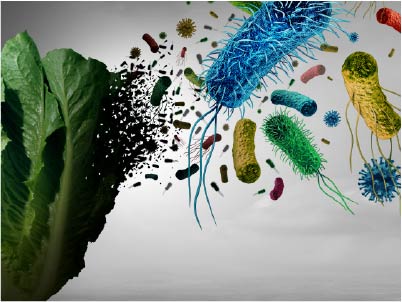
The Big 6 Foodborne Pathogens and How to Identify Them
Understanding Foodborne Pathogens and Ensuring Food Safety
Did you know that pathogens contaminate some foods? Foodborne pathogens are viruses, bacteria, or parasites that are dangerous to ingest. Consuming contaminated food or beverage can lead to foodborne illnesses. The Big 6 is a group of the most highly infectious foodborne pathogens, meaning they are more easily transmissible among food handlers.
These pathogens have a low infectious dose, contaminate the gastrointestinal system after ingestion, and are shed in large numbers through feces. Even when practicing thorough handwashing, the Big 6 can be transmitted easily from food handlers to consumers or other workers. However, if you practice food safety correctly and undergo food handler training, you can avoid infection altogether. First, let’s learn about what symptoms to watch out for.
The Big 6 and Their Symptoms:
How can a food handler identify pathogens
SalmonellaSymptoms include mild to severe diarrhea, fever, and abdominal cramps within 12 to 72 hours of infection. This illness can last 4 to 7 days in most cases, but in more severe cases, infected persons should be hospitalized for treatment.
ShigellaShigellosis can cause diarrhea, fever, and stomach cramps within 1 or 2 days after exposure. Shigella may still be passed to others even when the initial consumer exhibits no symptoms. This disease usually clears up within 5 to 7 days.
E. coliMany strains of E. coli are benign, but others cause sickness. While some cause diarrhea, others can cause respiratory illness, pneumonia, urinary tract infections, and other illnesses.
Hepatitis AThis infectious disease develops when the hepatitis A virus is transmitted through food contamination or the fecal-oral route. Symptoms include fatigue, nausea, stomach pain, low appetite, and jaundice. These usually clear up within two months of infection. Children 6 years old and younger often do not show symptoms.
Nontyphoidal SalmonellaThis infection can cause fever, diarrhea, abdominal pain, nausea, and vomiting. These symptoms occur within 6 to 72 hours after ingestion of Salmonella and can last 2 to 7 days.
NorovirusThis highly contagious virus is transmitted by contaminated food and beverage, surfaces, and infected people. As a result, the stomach and intestines may become inflamed, leading to nausea, diarrhea, stomach pain, and vomiting. These symptoms can range in severity.
Preventing InfectionIf you work in the food industry, practicing food safety is critical to prevention. There are many ways to prevent foodborne illness, such as quality cleaning measures, avoiding cross-contamination, and storing food properly. These are essential practices in the workplace.
To protect yourself and others, take the necessary food handler courses. ANSI-Accredited courses are quick and effective, so sign up today! Upon earning your food handler card and certification, you can implement food safety at your workplace and contribute to the prevention of foodborne illnesses.
Learn More About Food SafetySimply register with an email address, purchase your course, and complete it. All of our courses are structured in an easy to follow format.
Our food handler program is ANSI National Accreditation Board (ANAB) accredited to ensure you get the highest quality training.
Purchasing Food Handler courses for your employees? We offer discounts starting with purchases of just 5 courses.
Shop Food Handler Courses Now!



